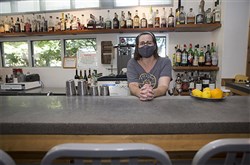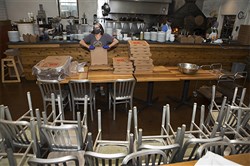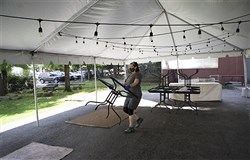VOL. 44 | NO. 36 | Friday, September 4, 2020
Restaurant workers had it made ... and then
By Catherine Mayhew
It was the equivalent of a massive rug being pulled out from under tens of thousands of people statewide.
The COVID-19 pandemic of 2020 blew up the hospitality industry, abruptly sending servers, bartenders and cooks – all of whom were in high demand and could change jobs on a whim during Nashville’s restaurant boom – home without a whiff of certainty about when they’d be able to come back.
State labor statistics for March showed that 61,100 jobs in food services and drinking establishments just went poof.
“It happened so fast,” says Caroline Galzin, a partner and general manager at Nicky’s Coal Fired. “We went from a regular great weekend to all of a sudden having to close.”
Rob Mortensen is president and CEO of Hospitality TN, a not-for-profit trade association representing the interests of Tennessee’s lodging, dining and tourism establishments. He says putting the brakes on restaurants and bars caused a devastating ripple effect immediately.
“Our industry got hit the hardest first,” he says. “A lot of it had to do with the shutdowns. It is definitely a family and we all play off each other. If we don’t have people downtown eating and going to attractions, we’re not going to have anybody in the hotels.”
What happened next is a mixture of desperation, hope and, as has happened so much during the pandemic, the creation of new and innovative ways to do business.
Two federal relief programs combined to give the displaced workers and restaurants a fighting chance – enhanced unemployment benefits of $600 a week from The Cares Act and the Paycheck Protection Program that provided forgivable loans to small businesses to get their workers back on the payroll. While restaurants applied for the loans, they urged their staffs to go ahead and get unemployment benefits to bridge the gap.
The Nashville Hospitality Professionals Facebook page, with more than 11,000 members, became a clearing house for workers trying to negotiate the unfamiliar rules and regulations of unemployment as state offices were overwhelmed with applications.
Alisa Martin, a bartender at City House before the pandemic shutdown, was one of the lucky ones whose unemployment was approved immediately.
“I didn’t feel the need to immediately find work because of unemployment,” she acknowledges. “I’ve always enjoyed working at City House, but that was the main thing. There was no reason for me to go anywhere else.”
The extra $600 in unemployment allowed a lot of restaurant and bar workers a safety valve to assess their next steps. After a couple of months, job leads started popping up on the Nashville Hospitality Professionals Page and some areas of the state were doing better than others.
High-volume tourism draws such as Sevierville were able to rebound more quickly, Mortensen says. And workers willing to work at chain restaurants also found opportunity.

Bartending used to keep Alisa Martin hopping at City House. She now has many more duties.
-- Photo By Michelle Morrow |The Ledger“Quick-service restaurants have done pretty well,” he adds. “The chains have the ability to kind of feed themselves from other sites.”
But those who had been longtime employees of locally owned restaurants had a different goal in mind. The staffs there were like families, and they just wanted to go home.
Going home
Pre-pandemic restaurants were convivial gathering places where patrons enjoyed not only food and drink but conversation and community. Now the dining rooms were empty and no one was bellying up to the bars.
Restaurant owners and managers were working overtime to figure out an emergency business model, a new business model … any model that would keep the doors open and bring back at least some of their staffs.
“We went from a high-end restaurant to a very classy drive-thru,” says Destin Weishaar, the general manager at Margot Café & Bar.
Some restaurants closed for a week or two to get their bearings before introducing a modified business plan. Others hurtled right in to take out.
“We were able to pivot overnight to a takeout model,” explains Katie Struzick, front of house manager and event coordinator at Lockeland Table. “We kept rocking and rolling through the whole thing. Hal (Holden-Bache, the co-owner and executive chef) and Jason (Lockman, the sous chef) never skipped a beat.
“They flipped their mentality of what a restaurant looks like. All of a sudden there were aluminum pans everywhere.”
Struzick says the restaurant didn’t furlough any of the staff of 23, although several people elected to take unemployment.”
Even pre-COVID, our staff has been there for a long time,” she continues. “There’s not a lot of turnover. If there is a position open, people seek us out. A lot of our staff comes from referrals. Lockeland Table – there’s just something about it that’s special. I really can’t imagine doing this with another group of people.”
Most restaurants did have to lay off staff and slowly hire them back as virus-related restrictions eased. City House’s Martin, a veteran of 11 years, left the restaurant as a bartender.
“Right now I do a little bit of everything. I serve, I back wait, I expo (expedite) and I’m an assistant manager.”
Like Martin, many of the staff that returned to other restaurants did a little bit of everything, and that included the chefs. Takeout food was the backbone of the new reality, and some restaurants tried unique approaches.
Margot branded their takeout menu as Mar-To-Go and offered a shortened menu of dishes that looked exactly as they did when the dining room was open. “We said ‘what’s going to look good in a box?’” Weisharr adds. “We were serving fully realized menu items.”

Takeout is king at many restaurants struggling to survive. But the lack of tablecloths and candlelight doesn’t mean to-go meals have to be boring or unpleasant to the eye.
-- Photo By Michelle Morrow |The LedgerCity House tried several approaches, selling special dessert packs, supper sacks to go and creating a store with pantry staples. “At this point, Tandy (Wilson, the chef and owner) said we’re just throwing spaghetti against the wall to see what sticks.” Martin notes.
The Paycheck Protection Program was a lifesaver for many restaurants that were able to rehire staff. “Without the PPP money, we wouldn’t have been able to reopen,” says Galzin of Nicky’s Coal Fired. “We had $30,000 in outstanding invoices and payroll.”
Still, says Hospitality TN’s Mortensen, there is an enormous question mark about the future.
“It’s an odd place for employees,” he says. “They’re hesitant to go back for fear of being safe and what if (the restaurants) shut down again? Or the restaurants go bankrupt? There’s a whole lot of uncertainly. And the restaurant owners can’t say to employees, ‘Hey, this is what the next six months look like or even what the next two weeks look like.”
The mask police
Before the shutdown, everyone in the front of the house knew their roles. Servers waited on customers, bartenders made the drinks and hosts and hostesses greeted clients and showed them to their seats.
None of them signed up to be the mask police or enforce social distancing. And, yet, here they are on the front lines of trying to contain a pandemic.
When restaurants began opening their dining rooms with restrictions, everyone had to learn to navigate this new and somewhat scary phase – both staff and customers.
“The general public doesn’t understand about all these restrictions,” says Margot’s Weishaar. “We can only seat a party of six, and they say why can’t you seat a party of nine and push two tables together?
“In the beginning months, when the mask mandate went into effect, there was some confusion. But we provided masks to those who didn’t have them. I’ve only had a handful of people come in and say this is stupid. And we’ve had a couple say I’m a doctor, you don’t have to wear a mask.
“People talk about how this has been this great pause. We have not been paused. People in the hospitality industry have not been paused. Restaurants and bars are sacred spaces right behind churches. I’m putting my health on the line so people can feel some sense of normalcy. But I’m not going to do that if people are rude to me.”
Weishaar is quick to point out that the vast majority of customers have been understanding and supportive. Most restaurant owners say the same thing.
Struzick says the Lockeland Table staff all contributed to its safety policy.
“We sat socially distanced apart and talked about how we were going to do it,” she explains.

City House’s Alisa Martin sets up the restaurant’s outdoor dining space. The expansion of outdoor seating has helped many restaurants stay open during the pandemic.
-- Photo By Michelle Morrow |The Ledger“We were safe in our own little bubble, and bringing people back into that bubble was kind of scary. We decided to have a friends and family soft opening so we could practice with people we know have been safe and were safe to be around. It was one of the best nights of my restaurant career. We looked around and said there is a safe way to do this.”
The fits and starts of basing restaurant capacity on an ever-changing set of virus statistics has been confusing and frustrating for some restaurateurs. As a result, Galzin and a group of other prominent chefs, restaurant owners and hourly workers created Action for Hospitality to focus on the protection, relief and welfare of hospitality workers.
“A lot of it came out of the frustration we were feeling about a lack of meaningful regulations,” Galzin explains.
Although she says the rules have become clearer, there’s still a lot of work to be done. The priorities of Action for Hospitality are a mask initiative to create guidance for the hospitality industry that can be shared with other states, to develop job resources for members and other hospitality workers and to move forward an initiative that creates rapid virus testing for hospitality workers.
In short, Galzin says, the goal is to get ahead of the virus instead of chasing after it with ever-changing regulations.
“We, as a state, are very divided on masks,” Mortensen points out. “And depending where you are, people are wearing them or not wearing them.
“What is it we’re trying to accomplish? Are we trying to defeat COVID? That’s not going to happen. If our goal is to minimize it then the question becomes what does that look like? Is it so many people in the hospital?
“We have become so focused on ways to defeat COVID and what we don’t realize is that we’re on a moving train and all we’re doing is speeding it up or slowing it down.
“If that’s the case, it’s a lot easier to convince people to wear masks.”
Silver linings
There have been some silver linings in this pandemic mess. Many restaurants are finding new ways of doing business that they may have never tried otherwise.
For Margot and City House, it was turning outside space into dining rooms. City House’s space is in the former employee parking lot. Margot already had patio space but now they have a sidewalk café as well with 11 additional tables.
“I kind of wonder why we didn’t do that before,” Weishaar says.
For Lockeland Table, using a QR Code has allowed the restaurant to get rid of printed menus entirely. The QR code (abbreviated from Quick Response code) allows patrons to read the menu by way of a special bar scan that’s placed on tables throughout the restaurant.
“You open up your camera on your phone, hover over the QR code and it takes you to the website,” Struzick adds. “Why haven’t we been doing this the whole time? There’s been a lot of good that’s come out of this bad situation.”
Nicky’s Coal Fired has completely restructured its labor model. In most restaurants, the back-of-house cooks and dishwashers are paid hourly while the front-of-house servers and bartenders make a base pay with tips boosting their income.
“We are now paying all of our employees $10 an hour and pooling all the tips,” Galvin says. “It’s great. It’s allowed us to pay everyone a more equitable wage. This is an opportunity for our industry as a whole to press pause and say how can we do this better?
“The way that this has affected the industry has put a big magnifying glass on operators. This is an opportunity for the industry to fight for better working conditions and wages.”
And everyone agrees that curbside takeout is now a permanent fixture in the restaurant landscape.
“We’re in interesting times and the way we stay in business is that everyone stays safe,” says Mortensen, who points to the Honky Tonk Hero campaign on Lower Broadway to encourage mask use and safe distancing after crowds of bar goers went without masks in close quarters this summer.
“We can’t have another shut down,” he continues. “Here’s the challenge. I get that we’re trying to save lives and that’s very important.
“But we’re destroying our restaurants, and that’s going to destroy our economy. We have to figure out how to live with this so that people can continue to go to work.
“We’re about to devastate an industry.”